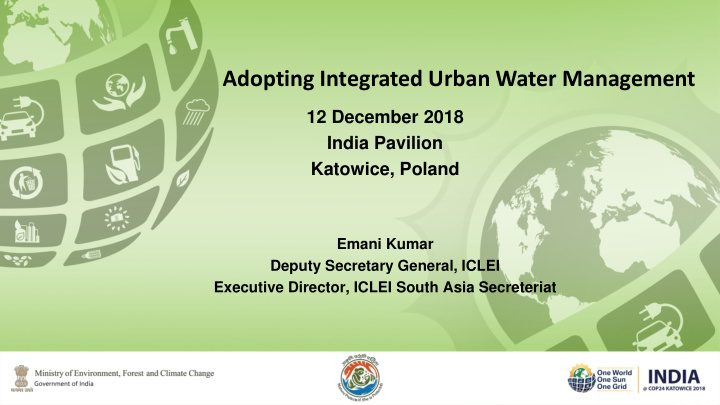



Adopting Integrated Urban Water Management 12 December 2018 India Pavilion Katowice, Poland Emani Kumar Deputy Secretary General, ICLEI Executive Director, ICLEI South Asia Secreteriat
India’s Water Sector Scenario India is blessed with an abundance of water resources and large rivers, but still it is currently facing the terrifying possibility of becoming a water scarce country by 2025. India is placed at 120th amongst 122 countries in the water quality index, with nearly 70% of water being contaminated 600 million Indians face high to extreme water stress and about 0.2 million people die every year due to inadequate access to safe water The water requirement by 2050 is likely to be 1,180 BCM, whereas the present- day availability is 695 BCM Cities are key in addressing climate change through integration of water energy nexus & climate resilience strategies into local development planning.
INDIAN CITIES AND WATER SECTOR v
Indian Cities Population 2014 2050 2030 410 million 1 590 million 2 814 million 2 US$ 1.2 trillion in capital investment required Equivalent to $134 per capita over the next 20 years to meet urban services per year, almost eight times the level of spending today 1 demand Climate risks to Indian Cities - heat stress, inundations , water shortages, droughts, environmental health risks and migration to urban areas. Climate Risk Increases in both mean minimum Increase of 7 – 20% in mean for Indian and maximum temperatures by 2 – annual precipitation Cities 3 4°C 1 World Urbanisation Prospects 2014 UN Report, 2 Mckinsey Global Institute. 3 Revi, A (2005).
Background Most of the cities bring water from distance sources (average 100km – 200 km) resulting in high NRW. Only 70 per cent of the urban households have access to piped water supply Though the per capita availability as reported ranges from 90 to 120 liters per day, but no city yet offers continuous water supply More than 40 percent of water produced in many Indian cities does not earn any revenue Water and its allied sectors like waste water and storm water drainage sectors work in silos. Insufficient infrastructure and lack of institutional reform I, impacting the efficiency of urban water sector
Key Programmes/initiatives National Water Mission: Goal 4 - Improving Water Use Efficiency by 20% by ensuring improved efficiency both on the demand side as well as the supply side.
ICLEI South Asia’s Projects on Integrated Water Management v
ICLEI - Local Governments for Sustainability ICLEI – Local Governments for Sustainability is a network of more than 1,750 local and regional governments, supported by a team of global experts, driving sustainable urban development worldwide.
Who we are ICLEI is the leading global network cities, towns and regions , committed to building a sustainable future, since 1990. 1750+ cities, town and regions active in 124+ countries impacting > 25% of global urban population with 300 staff in 22 offices
Towards Sustainable Cities What we do? How we promote urban sustainability We connect leaders We accelerate action We provide gateways to solutions
ICLEI’S Projects on Integrated Water Management
1. Adopting Integrated Urban Water Management for Indian Cities (AdoptIUWM) Capacity Building and Pilot interventions Water resources Training planning & action plans Project Project Partners Supported By
Integrated Urban Water Management for Indian Cities Ichalkaranji: : Reducing pollution load on water Jaisalmer: SWM & Revival of interlinked Pilot Interventions in India pond and traditional RWH structure Solapur: Ground water recharge Kishangarh: SWM & reduce pollution in the catchment areas of local water
Integrated Urban Water Management for Indian Cities Outcomes of pilot Interventions More than 15,00 direct Connected more than 30 Benefited more than Capacity building of more than 80 beneficiaries in 4 Indian house holds with SBM 5000 women and school officials from 4 ULB on IUWM and cities girls in slum areas waste management A multi stakeholder Recognized at IEC and peer learning activities Trained more than 35 city platform International Platform & on IUWM Toolkit by National Government
2. Integrated Rural Urban Water Management for Climate based Adaptations in Indian Cities (IAdapt) To institutionalize climate change adaptation measures through the creation of an enabling ecosystem to adopt and implement IUWM approaches and IWRM approaches at catchment level guided by participatory catchment planning, simple decision support tools, preparation of catchment level action plans and multipronged financing approaches. Partners Funded by
3. Integrated Urban Water Management and implementation in Rajasthan cities (Kishangargh & Ajmer) To build capacity of urban local bodies to mainstream integrated urban water management principal into municipal line function’s existing activities and planning process. • To secure local water bodies by restoration of catchment boundaries of local lakes/water bodies and reducing solid waste dumping. • IUWM Action plan • Implementation of the project in Kishangargh and Ajmer City Partners Funded by
Thank You! Emani Kumar, ICLEI Deputy Secretary General and Regional Director-ICLEI South Asia Secreteriat E-Mail: emani.kumar@iclei.org www.iclei.org, www.southasia.iclei.org
Recommend
More recommend